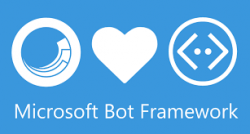Difference between revisions of "Microsoft chatbots"
| Line 21: | Line 21: | ||
==References== | ==References== | ||
| + | |||
| + | [[Category:2020New]] | ||
| + | [[Category:2020Object]] | ||
Revision as of 12:09, 17 March 2020
Microsoft Corporation is heavily invested in chatbots and chat-based interfaces, as CEO Satya Nadella believes they will soon become the primary way that people use the internet.[1] Microsoft has developed chatbots such as Cortana[2] and even a program to create your own chatbot called Bot Framework[3]. However, this page will be focused on Microsoft's efforts to create a collection of chatbots with emotional intelligence across the globe.
Contents
Background and history
The first chatbot with emotional intelligence capabilities that Microsoft developed is called Xiaoice. Xiaoice was launched in China in 2014. After much success, Microsoft developed Rinna in Japan in 2015. Next, Tay was released in 2016 in the United States, though the release did not last long as Tay quickly started tweeting politically incorrect phrases and was shut down. This was a huge learning experience for Microsoft and caused a complete revamping of their chatbot technologies. As a result, Zo was created in the United States later in 2016 as Tay's successor. From there, Ruuh was released in 2017 in India as well as Rinna in Indonesia.[4]
Xiaoice (China, 2014)
Xiaoice is without a doubt Microsoft's most successful chatbot with emotional intelligence. Xiaoice was released in China in May 2014 and now has well over 660 million online users worldwide. Xiaoice has a wide variety of incredible features from writing poems to writing songs to painting. Microsoft has continued to release new versions of Xiaoice over the years with more and more features, with their most recent version being the 7th generation of Xiaoice, which was released in August of 2019. Xiaoice is still available in China today.[5][6]
Rinna (Japan, 2015)
Rinna was released in Japan in 2015 and has over 7 million users. In 2018, Rinna came out with a new project called "Rinna Goes Local!" which was created by Microsoft developers in partnership with five local Japanese governments. This project was started to increase her appeal and user-base across Japan to areas outside of major urban areas. This project includes features for users to learn about each of these local regions by taking quizzes, participating in a multiple-choice story, or looking through a map of less well-known visitor spots. Rinna is still available in Japan today.[7]
Tay (US, 2016)
Tay, while very short-lived, was released in the United States in March 2016. One of Tay's features was a "repeat after me" capability, where users could tweet Tay a phrase and say "repeat after me" and then Tay would tweet that phrase from Tay's account. This resulted in users asking Tay to repeat politically incorrect and offensive phrases, causing the suspension of Tay. The reason for this problem was that Tay did not have any understanding of what was inappropriate and what was not. The mistakes made when developing and releasing Tay were a large learning experience for Microsoft and spearheaded a complete change in their approach to the development of their chatbots. Tay is still suspended today.[8]
Zo (US, 2016)
After Tay's suspension, Microsoft got right back to work to create a successor for Tay in the United States. This successor was Zo and was released later in 2016. Zo was the complete opposite of Tay, with an extensive set of rules created for content moderation. Microsoft also created a team that was dedicated to ensuring that Zo was able to appropriately maneuver any kind of conversation and ensuring that Zo would never make any inappropriate or offensive comments. Zo was very successful for a time, from releasing cool new features and ways for users to interact with Zo to being featured in many news stories. However, Zo was discontinued in 2019 and remains discontinued today.[9][10]
Ruuh (India, 2017)
Ruuh was released by Microsoft in India in 2017. In just one year, Ruuh reached over half-a-million users and had over 40 million conversations. Ruuh was able to communicate with users like a human would by relating to common interests, making users laugh, and providing support in tough times. Ruuh also had a painting feature where users could ask "do you paint" and Ruuh would provide image outlines for the user to choose from. Once the user picked an outline, Ruuh would color it in. Like Zo, Ruuh was trained to appropriately deal with offensive and sensitive topics. Ruuh is now discontinued.[11][12]
Rinna (Indonesia, 2017)
Rinna was released in Indonesia in August of 2017. Rinna has over 1.7 million users and can respond to local Indonesian languages such as Sundanese and Javanese. Rinna also has thee types of skills: games, drawing (like Xiaoice and Rinna in Japan), and AI for fun. Some of Rinna's games include “ABC 5 Dasar”, Cakata (Cari Kata), TeKat (Tebak Kata), and Escape Room. Rinna appears to still be available today.[13]
Ethical implications/dilemmas
References
- ↑ Walker, John. “Chatbot Comparison – Facebook, Microsoft, Amazon, and Google.” Emerj, 13 December 2019. https://emerj.com/ai-sector-overviews/chatbot-comparison-facebook-microsoft-amazon-google/
- ↑ “Cortana – Your personal productivity assistant.” Microsoft. https://www.microsoft.com/en-us/cortana
- ↑ “Microsoft Bot Framework.” Microsoft. https://dev.botframework.com/
- ↑ “Xiaoice.” Wikipedia, 6 March 2020. https://en.wikipedia.org/wiki/Xiaoice
- ↑ Dormehl, Luke. “Microsoft’s friendly Xiaoice A.I can figure out what you want — before you ask.” Digital Trends, 18 November 2018. https://www.digitaltrends.com/cool-tech/xiaoice-microsoft-future-of-ai-assistants/
- ↑ Spencer, Geoff. “Much more than a chatbot: China’s Xiaoice mixes AI with emotions and wins over millions of fans.” Microsoft News, 1 November 2018. https://news.microsoft.com/apac/features/much-more-than-a-chatbot-chinas-xiaoice-mixes-ai-with-emotions-and-wins-over-millions-of-fans/
- ↑ Microsoft Asia News Center. “Rinna the AI social chatbot goes out and about in Japan’s countryside.” Microsoft News, 18 September 2018. https://news.microsoft.com/apac/2018/09/18/rinna-the-ai-social-chatbot-goes-out-and-about-in-japans-countryside/
- ↑ Vincent, James. “Twitter taught Microsoft’s AI chatbot to be a racist asshole in less than a day.” The Verge, 24 March 2016. https://www.theverge.com/2016/3/24/11297050/tay-microsoft-chatbot-racist
- ↑ “Zo - Social AI.” Zo, 2020. zo.ai
- ↑ Stuart-Ulin, Chloe Rose. “Microsoft’s politically correct chatbot is even worse than its racist one.” Quartz, 31 July 2018. https://qz.com/1340990/microsofts-politically-correct-chat-bot-is-even-worse-than-its-racist-one/
- ↑ “Ruuh - Microsoft's AI-powered desi chatbot turns one.” Microsoft AI. https://www.microsoft.com/en-in/campaign/artificial-intelligence/ruuh-ai-chatbot-one-year-anniversary.aspx
- ↑ Foley, Mary Jo. “Microsoft launches Ruuh, yet another AI chatbot.” ZDNet, 29 March 2017. https://www.zdnet.com/article/microsoft-launches-ruuh-yet-another-ai-chatbot/
- ↑ “Profile - Rinna.” Rinna Remaja Artifisial, 2019. http://www.rinna.id/profile


